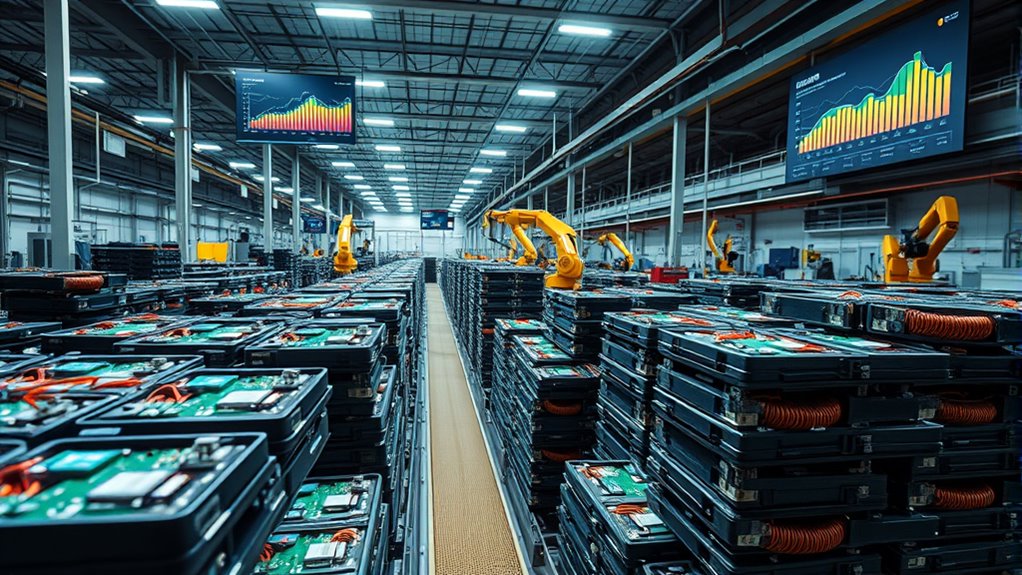The economics of battery recycling are influenced by fluctuating metal prices, high initial setup costs, and operational expenses, but rising raw material costs and strong market demand make recycling more attractive. Technological advances improve efficiency and profitability, while government incentives reduce financial barriers and encourage growth. Keep exploring how policies and tech progress are shaping the industry’s future, helping you understand how to navigate this crucial sector effectively.
Key Takeaways
- Fluctuating metal prices and high initial capital costs influence the profitability of battery recycling operations.
- Technological advancements in sorting and processing reduce operational costs and enhance metal recovery rates.
- Government incentives like subsidies and tax credits improve economic feasibility and encourage industry growth.
- Rising raw material costs increase the economic attractiveness of recycling as a cost-effective supply source.
- Market demand for sustainable products and circular economy practices boost the value of recycled battery materials.

As the demand for batteries continues to surge with the rise of electric vehicles and portable electronics, understanding the economics of battery recycling becomes essential. The growing need to recover valuable materials like lithium, cobalt, and nickel makes recycling an indispensable part of the supply chain. Government incentives play a significant role in shaping the economic landscape of this industry. Many governments offer subsidies, tax credits, and grants to encourage recycling facilities and develop sustainable practices. These incentives reduce the financial barriers for companies to invest in recycling infrastructure and research, making the process more economically viable. They also signal a commitment to environmental responsibility, motivating industry players to prioritize recycling efforts.
At the same time, technology advancements are transforming how efficiently and cost-effectively batteries can be recycled. Innovations in sorting, dismantling, and chemical processing are lowering operational costs and increasing recovery rates. For instance, improved pyrometallurgical methods now recover higher purity metals with less energy, while hydrometallurgical techniques reduce waste and processing time. These advancements not only decrease the overall costs but also open the door for recycling smaller and less valuable battery types, expanding market potential. As technology continues to evolve, the gap between raw material extraction costs and recycling expenses narrows, making recycling more competitive.
Additionally, increased awareness and consumer demand for sustainable products are driving the industry toward more circular economy practices which emphasize reuse and recycling, further strengthening the economic case for recycling investments. However, despite these positive influences, the economics remain complex. The initial capital investment for recycling facilities is high, and operational costs vary depending on battery types, contamination levels, and the purity of recovered materials. Fluctuating market prices for metals also impact profitability; when metal prices are low, recycling may become less attractive unless supported by strong government incentives or technological breakthroughs. Conversely, rising raw material costs make recycling more financially appealing, encouraging businesses to scale operations. Market dynamics are further influenced by consumer demand for sustainable products, which boosts the value of recycled materials and incentivizes companies to improve their processes.
In this evolving landscape, your understanding of how government incentives and technological progress intersect is essential. These factors can tip the economic scales, making recycling a more profitable and sustainable option. As policies become more favorable and technology advances, the industry is poised to become more efficient and economically viable. You, as an industry participant or observer, should keep a close eye on these developments, because they directly impact the costs, market opportunities, and long-term viability of battery recycling. Staying informed will help you better navigate the shifting economics and capitalize on emerging opportunities in this indispensable sector.
Frequently Asked Questions
How Do Government Policies Influence Battery Recycling Markets?
Government policies, like incentives and regulatory frameworks, profoundly influence battery recycling markets. When you see government incentives, it encourages you and others to invest in recycling technologies and infrastructure. Strict regulations push manufacturers to adopt eco-friendly practices, making recycling more viable. These policies can boost demand for recycled materials, lower costs, and foster innovation, ultimately shaping the growth and sustainability of the battery recycling industry.
What Are the Environmental Benefits of Battery Recycling?
You benefit environmentally from battery recycling because it extends battery lifespan and reduces toxic waste. Recycling prevents harmful materials, like heavy metals, from leaching into the soil and water, protecting ecosystems and human health. By reusing valuable components, you decrease the demand for new raw materials, lowering environmental impact. This process helps maintain cleaner environments, preserves natural resources, and supports sustainable energy solutions for future generations.
How Does Technological Innovation Impact Recycling Costs?
Technological advancements substantially impact recycling costs by making processes more efficient and less labor-intensive. When you adopt new innovations, you benefit from cost reduction through improved methods like automated sorting and better extraction techniques. These innovations streamline operations, reduce energy consumption, and minimize waste, ultimately lowering overall expenses. As a result, you can recycle batteries more affordably, encouraging broader adoption and supporting sustainable practices in the industry.
What Are the Primary Challenges in Scaling Battery Recycling?
You’d think scaling battery recycling would be easy, right? Ironically, it’s held back by cost barriers and technological hurdles. You face the challenge of making it financially viable while developing advanced methods to process diverse battery types. Infrastructure isn’t widespread, and maintaining quality standards is tricky. So, even with the push for greener tech, scaling remains a complex puzzle, slowing down the eco-friendly revolution you want to see.
How Do Global Supply Chain Issues Affect Recycling Market Stability?
Supply chain disruptions directly impact the battery recycling market by causing delays and shortages of essential materials and equipment. These issues lead to increased costs and market volatility, making it harder for you to predict supply and demand accurately. When global supply chains falter, recycling operations face uncertainties, which can slow growth and reduce profitability. Staying adaptable and diversifying sources can help mitigate some of these risks and stabilize your recycling efforts.
Conclusion
In the end, understanding the economics of battery recycling shows that the market’s growth hinges on balancing costs and demand. As the saying goes, “You can’t make an omelette without breaking eggs.” By investing wisely and innovating, you can turn the challenges into opportunities, ensuring a sustainable future. Stay informed and adaptable—because in this evolving landscape, those who seize the moment will reap the rewards.










